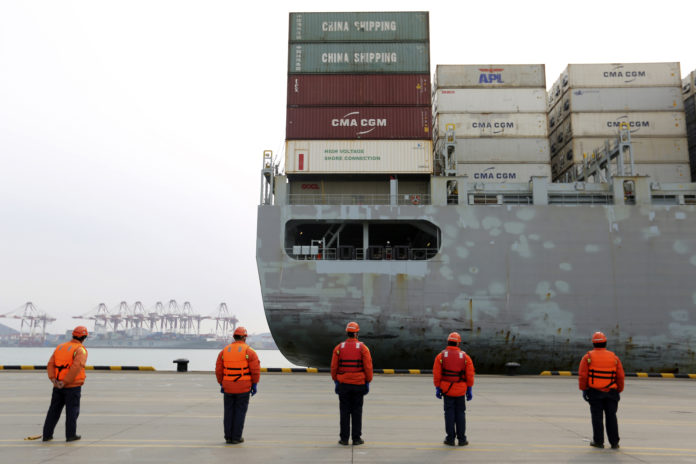
February 12, 2020 5:30 pm
NEW YORK (AP) — When the factory in China that makes Romy Taormina’s anti-nausea wristbands closed for the Lunar New Year in late January, she expected production to resume by early this month. But many factories across China are still closed to try to limit the spread of the coronavirus, leaving business owners in limbo.
“There’s no guarantee now when they’re going to be up and running,” says Taormina, who’s counting on a shipment of her Psi Bands to meet an increase in orders from Target stores.
Many U.S. small business owners are facing a shortage of products or components because suppliers, who closed for the weeks-long New Year holiday, remain shut due to the virus that has killed more than 1,100 people. Even owners who stocked up in advance of the holiday are worried about a prolonged outbreak, looking for alternate ways to fill orders and even considering moving their manufacturing to another country.
It has been hard for U.S. businesses to get information about how long the closings might last. After hearing rumors for a week, Taormina found out only this past Monday from her manufacturer that it was closed and didn’t know when it would reopen. The factory closed Jan. 18 and had expected to get back to work Feb. 2.
Taormina keeps an extra six weeks of inventory on hand for emergencies. But it can take six weeks for shipments to travel by sea and make it through customs. If factory shutdowns are prolonged, “it’s going to be a tight squeeze,” says Taormina, whose company is based in Pacific Grove, California.
Eugene Nadyrshin has been meeting with manufacturers in the Silicon Valley to build prototypes for the computer and electronics hardware he can’t get from China. He realized around Jan. 26 that he needed to find an alternate way of getting the prototypes; his clients need them in order to decide whether to go forward with production.
“We have some facilities ourselves but often involve other factories for specialized components,” says Nadyrshin, co-founder of San Francisco-based CAD It App. He wants to avoid his customers growing impatient and taking their business elsewhere.
The worry for businesses is that it’s impossible to know how long the wave of illnesses will last. The SARS virus that first appeared in China in 2002 caused a global epidemic that didn’t end until July 2003, according to the World Health Organization.
Scott Thompson’s suppliers in China make ribbon and other components for the hoodies and other garments his company, The Saints Sinphony, assembles in San Diego. He’s worried about meeting deadlines to ship goods to his retail customers; he must ship in June so stores will have merchandise ready for the colder weather.
“They need them to be delivered by a certain time, or otherwise they’ll cancel,” Thompson says. “If we get stuck with the extra product, I could lose a lot of money.”
Thompson is considering moving production to Turkey, where he has also used factories. But the process of switching to a new manufacturer takes time, with samples going back and forth between the factory and his company; at a minimum it takes 30 days. If China’s factories aren’t producing again in three to four weeks, Thompson says he may have no choice but to make a change.
Sam Jackson doesn’t have that option. While he had a large shipment of sandals sent before the New Year, giving him a cushion, he’s worried about the upcoming peak season for his sales that begins in March. His Denver-based company, Deco Slides, already invested $50,000 to get sandals made at a Chinese factory, and estimates it would cost another $40,000 to have them manufactured elsewhere.
“We don’t have the resources to move production out of China at this point,” says Jackson.
Gregory Stoller, who teaches business strategy and innovation at Boston University’s Questrom School of Business, notes that U.S. companies began thinking about alternate manufacturing sites like Vietnam and Latin America when the Trump administration’s tariffs on Chinese goods drove up prices on imported goods.
“But none of them has the infrastructure that China has been pouring money into for the past 20 years,” Stoller says. That means it’s harder to get goods made and shipped in countries which are still building their factories, roads, bridges and transportation systems.
Some U.S. owners have gotten some work done with Chinese designers who are working at home. Jason Rosenfeld of Scenic Labs has been able to get designs and blueprints emailed from China. He’s used them to create prototypes on a 3D printer and send those to customers.
Rosenfeld, whose Kinnelon, New Jersey-based company sells lighting used in film-making and broadcasts, increased his inventory before the New Year, expecting a three-week production hiatus. Now, he says, “I’m asking on some orders for dealers to take partial shipments.” And while he has product upgrades coming up, he will hold off on orders for the older equipment when factories are running again.
“I don’t want to be stuck with hundreds or thousands of units,” he says.
Companies that have goods manufactured in China aren’t the only ones affected. Two clients of Kevin Mercuri’s public relations firm, both China-based, put projects on hold. He’s had to look elsewhere to make up the revenue shortfall.
“These are two very large clients who we were basing our forecast for the second quarter and beyond on,” says Mercuri, CEO of New York-based Propheta Communications.
He’s reaching out to previous clients and new prospects to bring in revenue while waiting to see if his clients in China can restart their projects.
“Any good business person has a Plan B in the back of their mind,” he says.